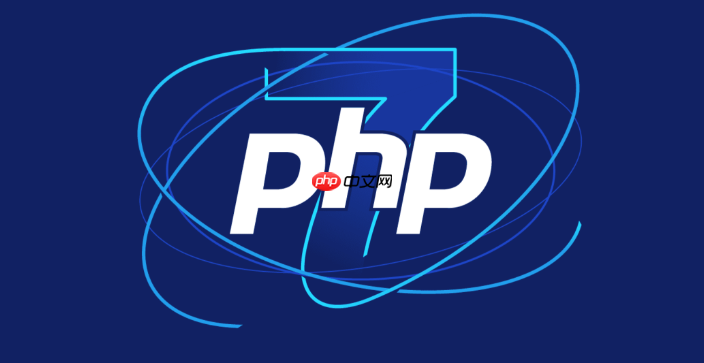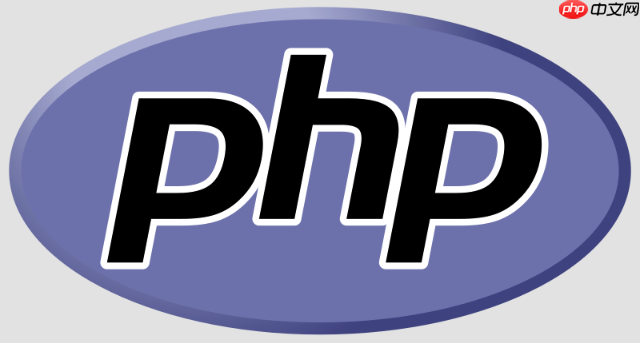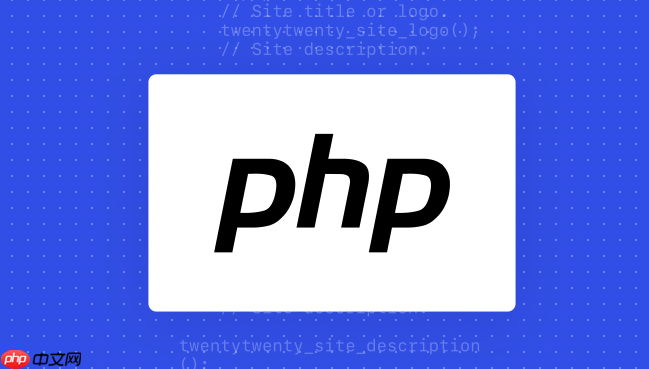 Backend Development
Backend Development
 PHP Tutorial
PHP Tutorial
 PHP realizes multi-user blog system monetization PHP blog content management and profit solution
PHP realizes multi-user blog system monetization PHP blog content management and profit solution
PHP realizes multi-user blog system monetization PHP blog content management and profit solution
Jul 23, 2025 pm 06:03 PMTo build a monetizable PHP multi-user blog system, you need to build a solid technical foundation and then design a business model; 2. Data security must be pre-processed to prevent SQL injection, password salt hashing, XSS/CSRF defense, and regular patch updates; 3. Performance optimization relies on database indexing, caching mechanism (Redis), CDN to accelerate static resources, and asynchronous queue processing tasks; 4. Content review can adopt a hybrid mode of pre- (new user) and post- (old user) combined with AI recognition and keyword filtering; 5. In addition to advertising, the profit method can also provide paid subscriptions (customized domain names, data analysis), rewards, knowledge payment, affiliate marketing and event sponsorship.

Building a multi-user blog system based on PHP is not just about realizing content release. It is more like building a small content ecosystem, with the core lying on how to effectively manage user-generated content and find sustainable profit points from it. This requires us to break out of a purely technical perspective and think about the integration of the platform's user experience, content quality and business model.

Solution
To realize a monetizable PHP multi-user blog system, you must first have a robust technical foundation, and then an exquisite business model design.

From a technical implementation perspective, the system needs a complete set of user authentication and authorization mechanisms, such as OAuth2 or JWT, to handle multi-user login and API access. Each user should have an independent dashboard for publishing, editing, and managing their own articles, including drafts, publishing, deleting, etc. In terms of article content management, a rich text editor (such as TinyMCE or Quill) is integrated to support multimedia uploads such as pictures and videos. In database design, in addition to regular user tables and article tables, we also need to consider related tables such as classification, labels, comments, likes, and read volumes.
The core of monetization lies in "service" and "traffic". The most direct way to monetize is advertising, but it is necessary to avoid excessive intrusion of the user experience. You can integrate Google AdSense, or work directly with brands to display ads at specific locations. A more advanced way of playing is "pay for content" or "premium feature subscription". For example, it provides more powerful data analysis tools, custom domain name binding, article promotion services, etc. for content creators as value-added points for paid subscriptions. For readers, you can try the "reward" feature, or provide the option to "paid reading" certain exclusive, high-quality content.

Content management is not only a technical job, but also an operation job. The system needs a powerful backend management interface, allowing administrators to review articles, manage users, process reports, and statistical data. A content scoring mechanism can be introduced, or the content quality can be evaluated based on user interaction data (such as number of comments and sharing) to determine which content is worth recommending, which needs to be optimized or even removed from the shelves.
How to ensure data security and performance optimization of PHP multi-user blog system?
When building multi-user blog systems, data security and performance optimization are two uncompromising cornerstones. I personally think that many times developers will pay too much attention to function implementation and put security and performance in a secondary position, which is actually a big hidden danger.
In terms of data security, the most basic thing is that database operations must use prepared statements (Prepared Statements) to eliminate the possibility of SQL injection. User passwords must be stored with salt hash and using strong encryption algorithms, such as Bcrypt or Argon2, and must not be stored in plaintext. In addition, XSS (cross-site scripting attack) and CSRF (cross-site request forgery) are common vulnerabilities in web applications. They must be strictly escaped when outputting content at the front end, and CSRF Token verification must be added when submitting the form. At the server level, regular updates to PHP versions, web servers (such as Nginx/Apache) and operating system patches, configure firewalls, and restrict unnecessary port opening are all basic operations, but many people will ignore them.
Performance optimization is a continuous iterative process. First of all, database queries are a big bottleneck, and it is necessary to index commonly used query fields to avoid full table scanning. For pages with high concurrent access, introducing a caching mechanism is crucial. Whether it is page cache or data cache (such as Redis or Memcached), it can significantly reduce database pressure. Static resources (pictures, CSS, JS) can be considered for CDN acceleration. The PHP code itself should also be optimized to avoid unnecessary loops and calculations, and to use memory reasonably. Asynchronous task processing (such as sending emails, generating reports) can be used to share the pressure of the main process with message queues (such as RabbitMQ or Kafka). Sometimes, a simple image compression and lazy loading can bring huge performance gains, and these details are often overlooked.
What are the mainstream content management and review mechanisms for multi-user blog platforms?
Content management and review are the core operation links of multi-user platforms, which directly determine the quality of platform content and community atmosphere. In my opinion, this is not only a technical implementation, but also a strategic balance.
The most common one is the "pre-review" or "post-review" of content published by users. Pre-authorization means that the content published by users must be reviewed by the administrator or a specific role before it can be launched. This can effectively control the quality of the content, but will affect the release efficiency. Post-review means that the content is first launched and then processed through user reports or system inspection. This method is more conducive to the rapid growth of content, but it requires higher response speed and automated recognition capabilities of the audit team. Many platforms will adopt a hybrid model: new users or sensitive content adopts pre-authorized review, while old users or ordinary content adopts post-authorized review.
At the technical level, a keyword filtering system can be established to automatically identify and intercept sensitive words and spam information. Images and video content can integrate AI recognition services to automatically identify pornography, violence and other illegal content. In addition, a user reporting system is indispensable, which allows community members to participate in content governance and provide manual supervision. The administrator background needs to provide powerful content management tools, including but not limited to: article list, batch operation, content editing, user ban/ban, IP blacklist, etc.
In addition to advertising, what other ways can PHP multi-user blog system achieve profit growth?
In addition to the traditional advertising model, multi-user blog systems actually have many innovative monetization paths, which often better reflect the value and differentiation of the platform.
A very effective way is "value-added services". Advanced feature subscriptions can be provided to bloggers, such as:
- Custom domain name binding : Make the author's blog look more professional and have his own brand.
- Advanced data analysis : Provides more detailed reading volume, user portraits, and interactive data to help authors optimize content strategies.
- SEO optimization toolkit : built-in keyword analysis, site link optimization suggestions, etc., to improve the search engine ranking of the author's articles.
- More storage space/bandwidth : This is a necessity for authors with more pictures and videos.
- Content promotion service : Allow authors to pay to display their articles on the platform homepage and recommendation positions to get more exposure.
The other direction is "community economy". "Reward" or "sponsor" features can be introduced to allow readers to directly support content creators they like. The platform can withdraw a certain proportion of service fees from it. Going further, a "knowledge payment" or "digital product transaction" module can be built, allowing authors to sell e-books, courses, templates, paid consulting services, etc. on their blog pages, and the platform can also take commissions.
You can also consider "affiliated marketing" or "content e-commerce". The platform can work with specific brands to display product links next to relevant content, and the platform receives commissions when users purchase through these links. Or, if the platform content has high verticality, you can even operate some content-related products.
Finally, if the platform user scale is large enough, you can also consider holding online or offline "events" or "summits", charging ticket fees, or making a profit through brand sponsorship. These diversified profit models can allow the platform to no longer rely solely on advertising, thus having stronger risk resistance and greater growth space.
The above is the detailed content of PHP realizes multi-user blog system monetization PHP blog content management and profit solution. For more information, please follow other related articles on the PHP Chinese website!

Hot AI Tools

Undress AI Tool
Undress images for free

Undresser.AI Undress
AI-powered app for creating realistic nude photos

AI Clothes Remover
Online AI tool for removing clothes from photos.

Clothoff.io
AI clothes remover

Video Face Swap
Swap faces in any video effortlessly with our completely free AI face swap tool!

Hot Article

Hot Tools

Notepad++7.3.1
Easy-to-use and free code editor

SublimeText3 Chinese version
Chinese version, very easy to use

Zend Studio 13.0.1
Powerful PHP integrated development environment

Dreamweaver CS6
Visual web development tools

SublimeText3 Mac version
God-level code editing software (SublimeText3)

Hot Topics
 What is Ethereum? What are the ways to obtain Ethereum ETH?
Jul 31, 2025 pm 11:00 PM
What is Ethereum? What are the ways to obtain Ethereum ETH?
Jul 31, 2025 pm 11:00 PM
Ethereum is a decentralized application platform based on smart contracts, and its native token ETH can be obtained in a variety of ways. 1. Register an account through centralized platforms such as Binance and Ouyiok, complete KYC certification and purchase ETH with stablecoins; 2. Connect to digital storage through decentralized platforms, and directly exchange ETH with stablecoins or other tokens; 3. Participate in network pledge, and you can choose independent pledge (requires 32 ETH), liquid pledge services or one-click pledge on the centralized platform to obtain rewards; 4. Earn ETH by providing services to Web3 projects, completing tasks or obtaining airdrops. It is recommended that beginners start from mainstream centralized platforms, gradually transition to decentralized methods, and always attach importance to asset security and independent research, to
 What are the websites for real-time price query of Bitcoin? Recommended websites that can view Bitcoin K-line and depth chart
Jul 31, 2025 pm 10:54 PM
What are the websites for real-time price query of Bitcoin? Recommended websites that can view Bitcoin K-line and depth chart
Jul 31, 2025 pm 10:54 PM
In the digital currency market, real-time mastering of Bitcoin prices and transaction in-depth information is a must-have skill for every investor. Viewing accurate K-line charts and depth charts can help judge the power of buying and selling, capture market changes, and improve the scientific nature of investment decisions.
 BTC digital currency account registration tutorial: Complete account opening in three steps
Jul 31, 2025 pm 10:42 PM
BTC digital currency account registration tutorial: Complete account opening in three steps
Jul 31, 2025 pm 10:42 PM
First, select well-known platforms such as Binance Binance or Ouyi OKX, and prepare your email and mobile phone number; 1. Visit the official website of the platform and click to register, enter your email or mobile phone number and set a high-strength password; 2. Submit information after agreeing to the terms of service, and complete account activation through the email or mobile phone verification code; 3. After logging in, complete identity authentication (KYC), enable secondary verification (2FA), and regularly check security settings to ensure account security. After completing the above steps, you can successfully create a BTC digital currency account.
 Ethereum ETH latest price APP ETH latest price trend chart analysis software
Jul 31, 2025 pm 10:27 PM
Ethereum ETH latest price APP ETH latest price trend chart analysis software
Jul 31, 2025 pm 10:27 PM
1. Download and install the application through the official recommended channel to ensure safety; 2. Access the designated download address to complete the file acquisition; 3. Ignore the device safety reminder and complete the installation as prompts; 4. You can refer to the data of mainstream platforms such as Huobi HTX and Ouyi OK for market comparison; the APP provides real-time market tracking, professional charting tools, price warning and market information aggregation functions; when analyzing trends, long-term trend judgment, technical indicator application, trading volume changes and fundamental information; when choosing software, you should pay attention to data authority, interface friendliness and comprehensive functions to improve analysis efficiency and decision-making accuracy.
 VSCode settings.json location
Aug 01, 2025 am 06:12 AM
VSCode settings.json location
Aug 01, 2025 am 06:12 AM
The settings.json file is located in the user-level or workspace-level path and is used to customize VSCode settings. 1. User-level path: Windows is C:\Users\\AppData\Roaming\Code\User\settings.json, macOS is /Users//Library/ApplicationSupport/Code/User/settings.json, Linux is /home//.config/Code/User/settings.json; 2. Workspace-level path: .vscode/settings in the project root directory
 btc trading platform latest version app download 5.0.5 btc trading platform official website APP download link
Aug 01, 2025 pm 11:30 PM
btc trading platform latest version app download 5.0.5 btc trading platform official website APP download link
Aug 01, 2025 pm 11:30 PM
1. First, ensure that the device network is stable and has sufficient storage space; 2. Download it through the official download address [adid]fbd7939d674997cdb4692d34de8633c4[/adid]; 3. Complete the installation according to the device prompts, and the official channel is safe and reliable; 4. After the installation is completed, you can experience professional trading services comparable to HTX and Ouyi platforms; the new version 5.0.5 feature highlights include: 1. Optimize the user interface, and the operation is more intuitive and convenient; 2. Improve transaction performance and reduce delays and slippages; 3. Enhance security protection and adopt advanced encryption technology; 4. Add a variety of new technical analysis chart tools; pay attention to: 1. Properly keep the account password to avoid logging in on public devices; 2.
 USDT virtual currency purchase process USDT transaction detailed complete guide
Aug 01, 2025 pm 11:33 PM
USDT virtual currency purchase process USDT transaction detailed complete guide
Aug 01, 2025 pm 11:33 PM
First, choose a reputable trading platform such as Binance, Ouyi, Huobi or Damen Exchange; 1. Register an account and set a strong password; 2. Complete identity verification (KYC) and submit real documents; 3. Select the appropriate merchant to purchase USDT and complete payment through C2C transactions; 4. Enable two-factor identity verification, set a capital password and regularly check account activities to ensure security. The entire process needs to be operated on the official platform to prevent phishing, and finally complete the purchase and security management of USDT.
 Stablecoin purchasing channel broad spot
Jul 31, 2025 pm 10:30 PM
Stablecoin purchasing channel broad spot
Jul 31, 2025 pm 10:30 PM
Binance provides bank transfers, credit cards, P2P and other methods to purchase USDT, USDC and other stablecoins, with fiat currency entrance and high security; 2. Ouyi OKX supports credit cards, bank cards and third-party payment to purchase stablecoins, and provides OTC and P2P transaction services; 3. Sesame Open Gate.io can purchase stablecoins through fiat currency channels and P2P transactions, supporting multiple fiat currency recharges and convenient operation; 4. Huobi provides fiat currency trading area and P2P market to purchase stablecoins, with strict risk control and high-quality customer service; 5. KuCoin supports credit cards and bank transfers to purchase stablecoins, with diverse P2P transactions and friendly interfaces; 6. Kraken supports ACH, SEPA and other bank transfer methods to purchase stablecoins, with high security





